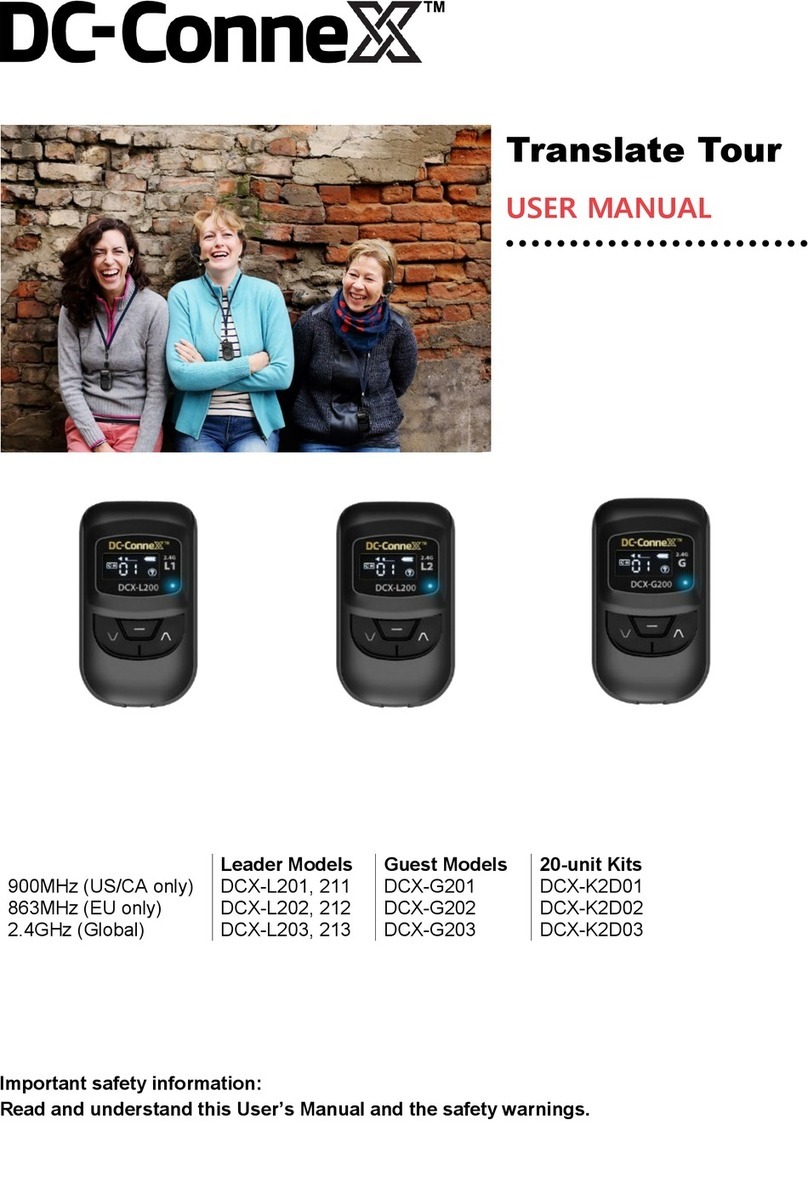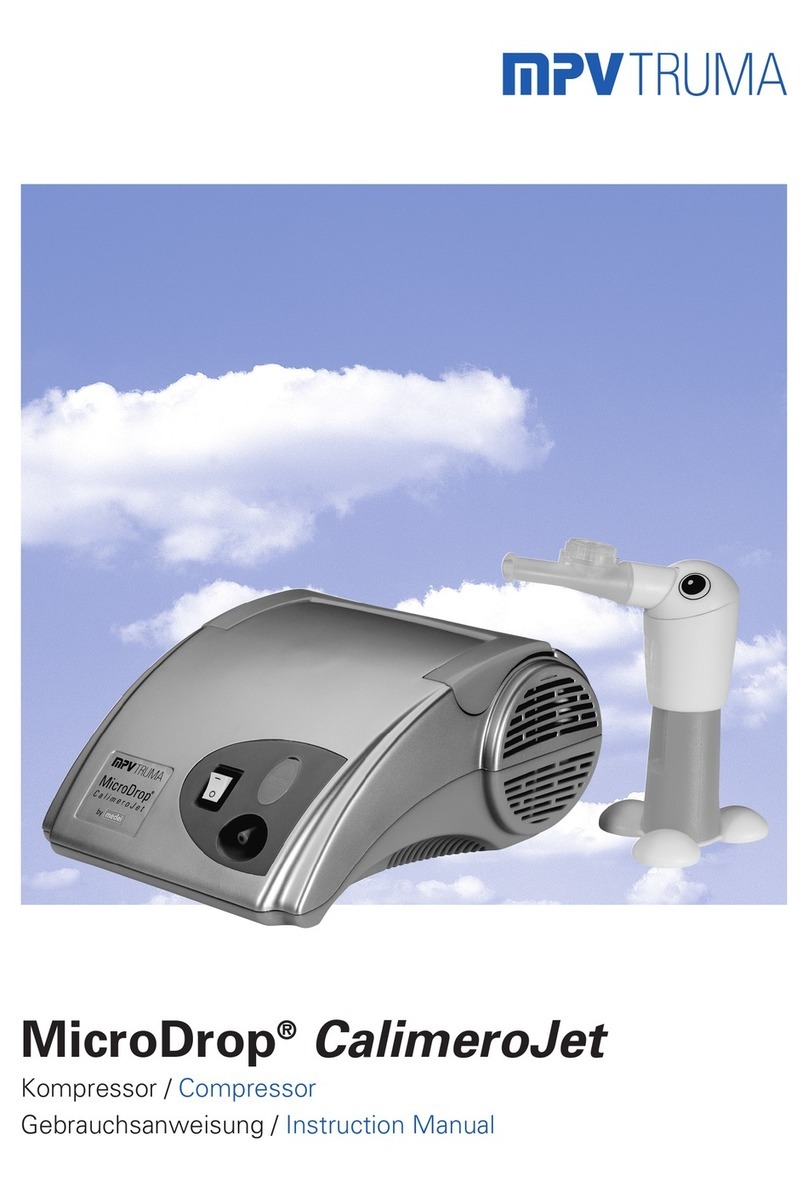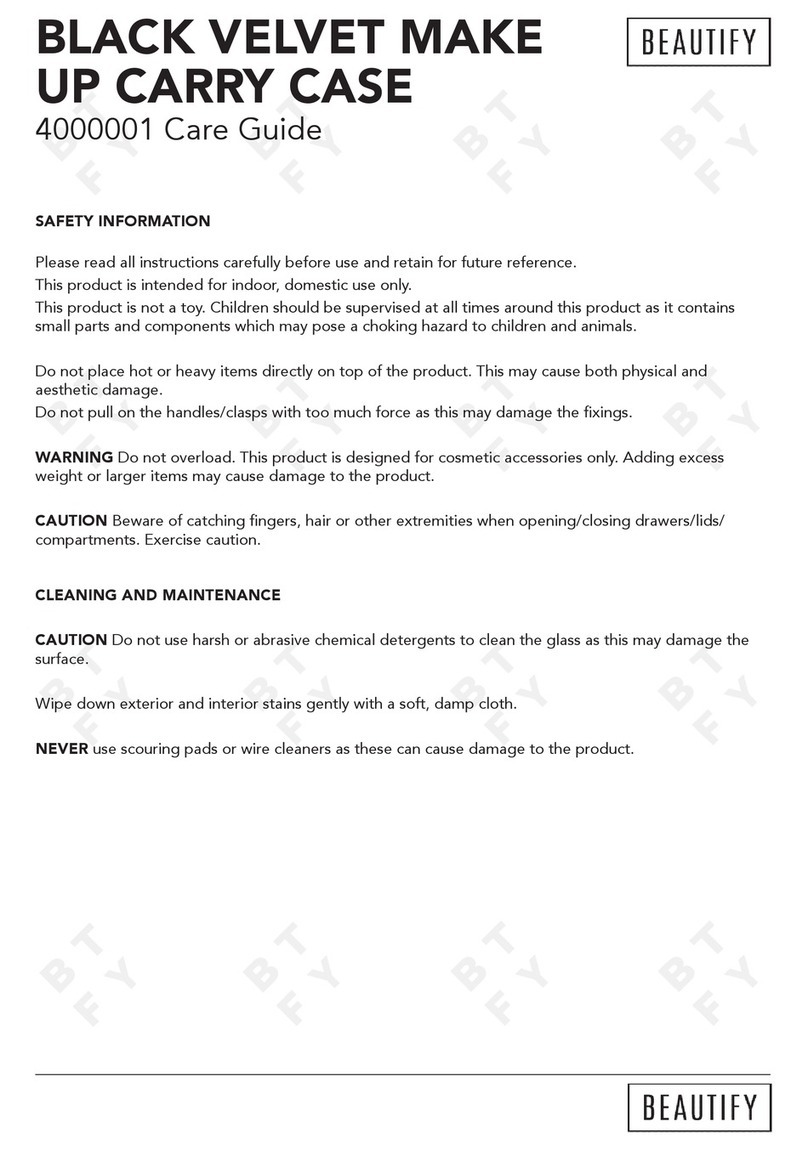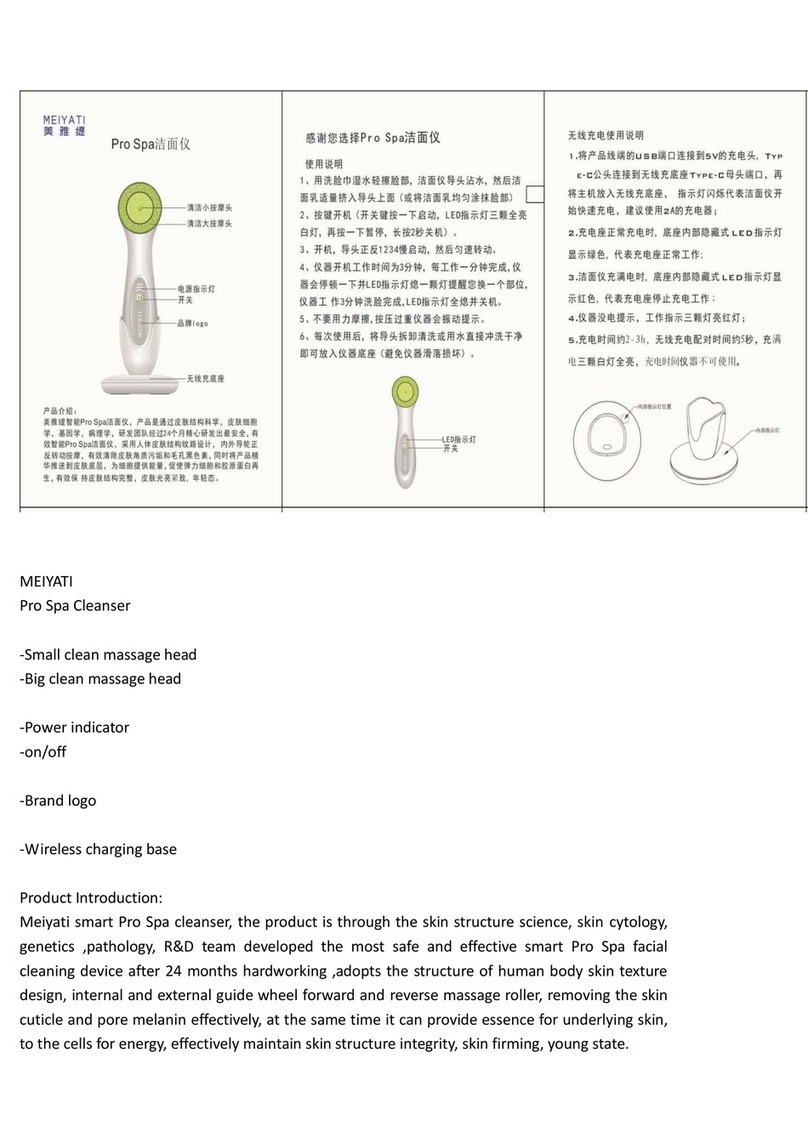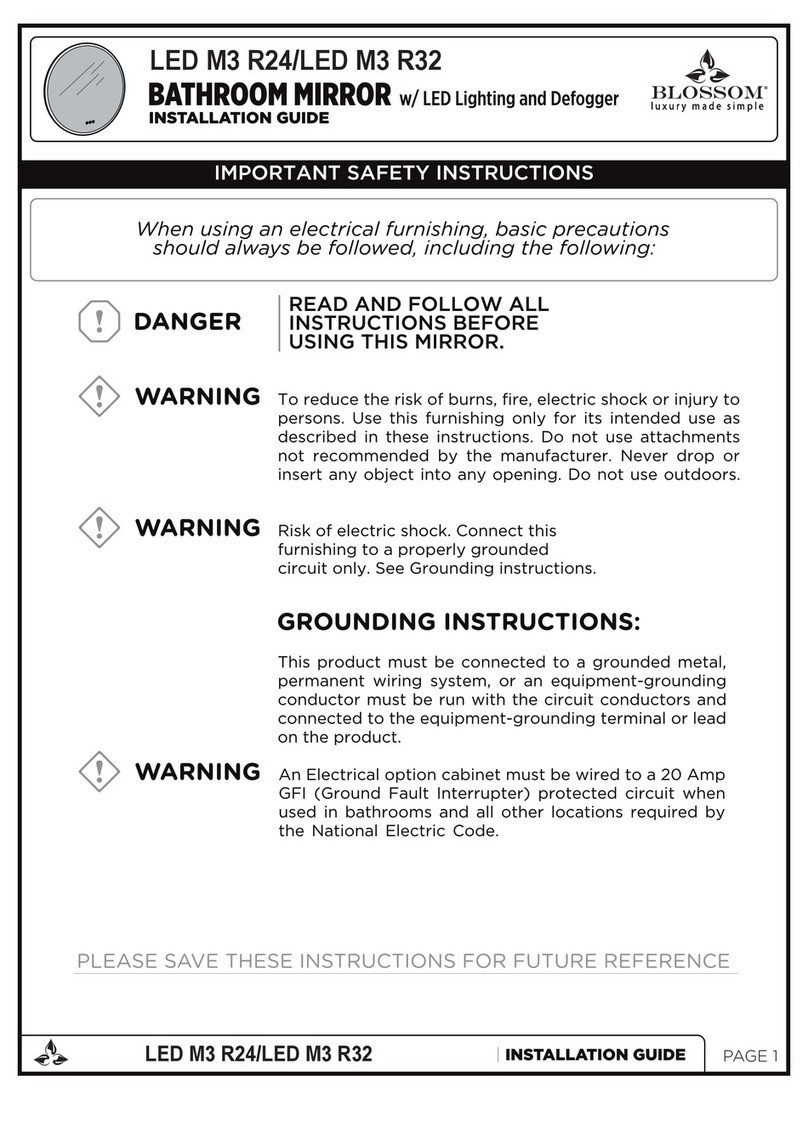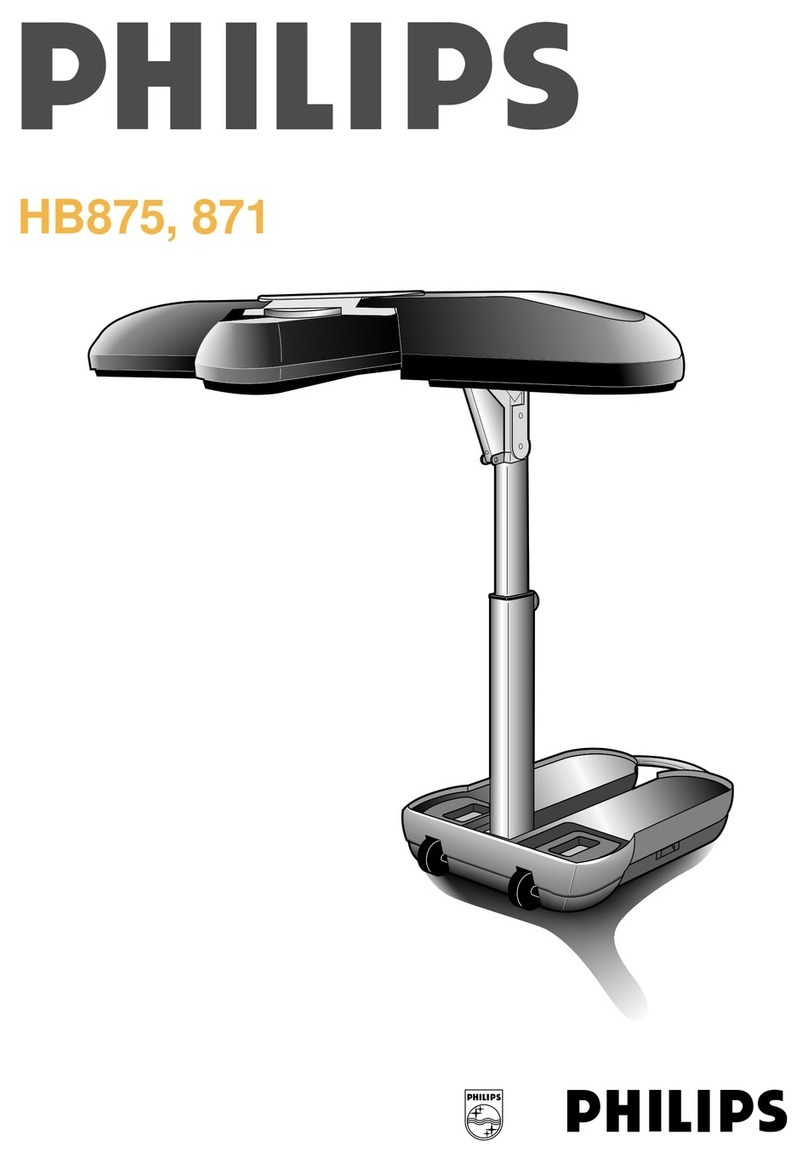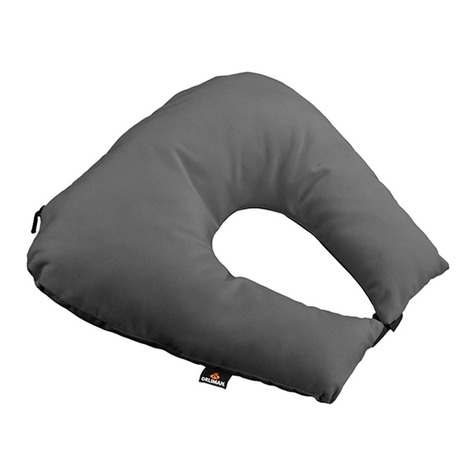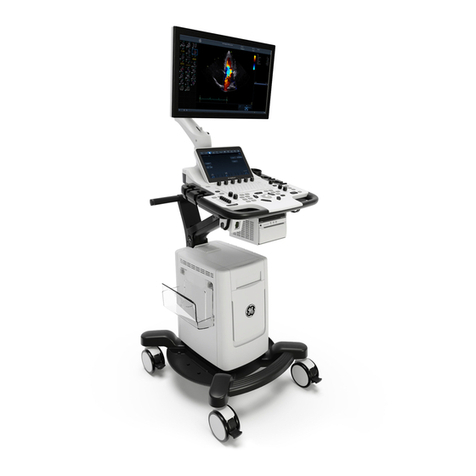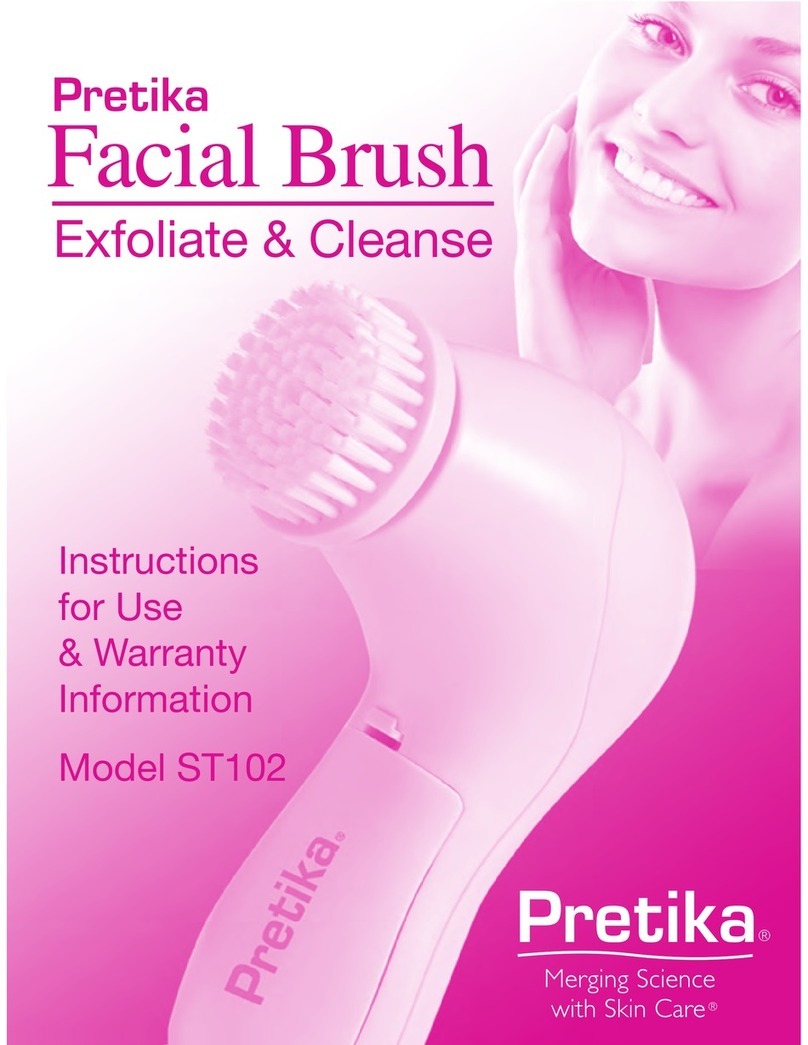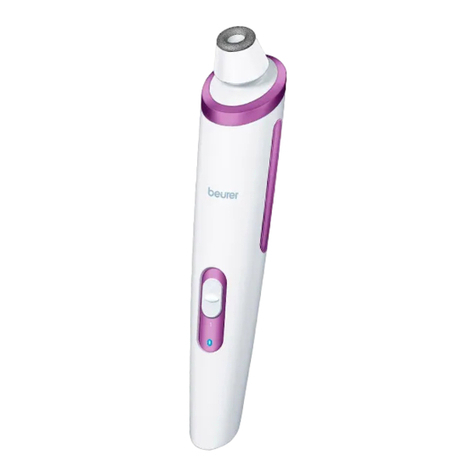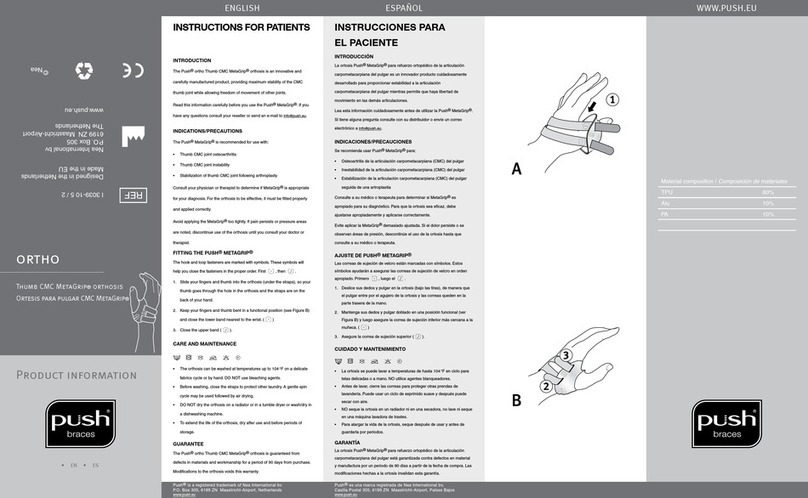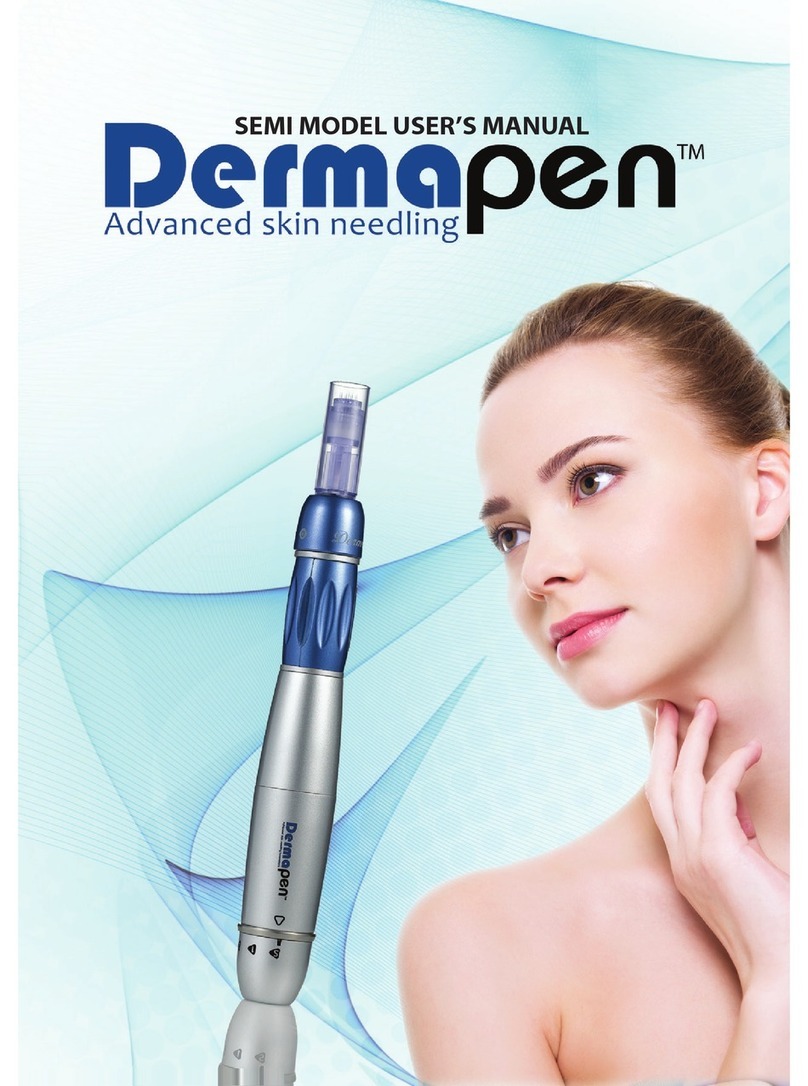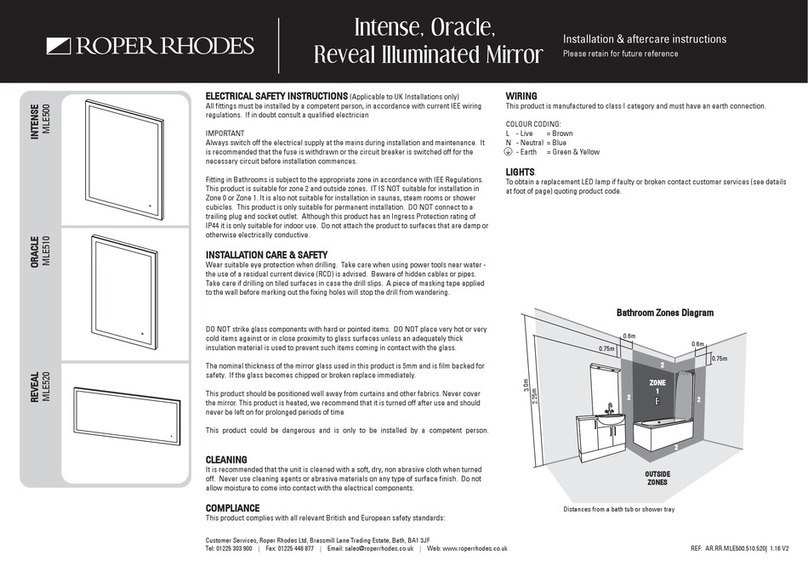Dittmann TGS 440 User manual

TGS 440
1
0123
•
•
•
•
•
•
•
•
•
•
Version 1, 2014-03
Radio TENS device for nerve stimulation with the aid of
stimulation current
2-channel device (TENS stimulators A and B)
Comfortable control of the TENS stimulators using the
remote control or directly on the stimulators
TENS stimulators A and B can be used and controlled
individually or simultaneously
Pre-programmed application sequence with therapy
duration of 30 minutes
20 levels for output intensity
Frequency range from 5 to 125 Hz
Pulse duration of 130/250 µs
Warranty: 24 months
Contains: 2x TENS stimulators (A and B), 1x remote
control, 2x adhesive electrode pads, 1x instruction
manual, 6x 1.5 V AAA batteries
INSTRUCTION MANUAL
RADIO TENS DEVICE TGS 440
Handelshaus Dittmann GmbH
Kissinger Straße 68
D-97727 Fuchsstadt
www.dittmann-gmbh.com
KEF439
A
Handelshaus Dittmann GmbH
Kissinger Straße 68
D-97727 Fuchsstadt
www.dittmann-gmbh.com
KEF439
B
GB

1.0
2.0
2.1
2.2
3.0
3.1
3.3
3.4
3.5
3.6
3.7
3.8
4.0
4.1
4.2
4.3
5.0
6.0
7.0
8.0
9.0
10.0
11.0
12.0
13.0
3
4
4
4
5
5
5
6
6
7
7
8
9
9
10
11
11
12
12
14
16
19
20
22
24
2
Information concerning resistance to electromagnetic interference
Malfunctions, troubleshooting
Examples of the correct position of the adhesive electrode pads
Remote control
Commissioning of the radio TENS device
Designation and functionality of the radio TENS device
Battery change information concerning batteries
Disposal of the radio TENS device
Scope of delivery / contents
Cleaning and care of the radio TENS device
Storage / maintenance of the radio TENS device
Areas where the adhesive electrode pads must not be applied
Areas where the adhesive electrode pads are applied
Usage of the radio TENS device
Usage by children and adolescents
Application for which the radio TENS device is not suited
Application for which the radio TENS device is suited
Usage / environment for which the radio TENS device is not suited
Usage / environment for which the radio TENS device is suited
General safety instructions
Safety instructions
Information concerning the TENS therapy
Characteristics of a TENS device
Basic information
Definition of symbols
No. Topic Page
TABLE OF CONTENTS
GB

14.0
15.0
16.0
17.0
18.0
25
26
27
28
29
3
D
Warning / danger: The device must not be used by persons with a
pacemaker!
These instructions must be followed under all circumstances!
Warning / danger: If not used correctly, there might be the risk of serious
injury, damage and mortal danger!
Read and follow the instruction manual!
The symbols refer to the following content:
The safety symbols shown in this instruction manual contain information concerning the
correct use of the radio TENS device and your safety.
1.0 Definition of symbols
Dear purchaser,
Congratulations on your purchase of a new radio TENS device TGS
440 and thank you for your trust. In order to ensure optimal
functionality and operation of your radio TENS device, please read the
instruction manual before using the device for the first time. This
guarantees a long useful life of this product.
Warranty
Technical specification, symbols, pictograms
Information concerning resistance to electromagnetic interference
Information concerning resistance to electromagnetic interference
Information concerning resistance to electromagnetic interference
No. Topic Page
TABLE OF CONTENTS GB

4
The device uses low-frequency electric currents for therapeutic purposes. The induced
electric pulses, their intensity, frequency and frequency width are controlled by the
respective application programme. By means of adhesive electrode pads applied on the
skin, the electric pulses are transmitted to the nervous system and the muscles.
The current flows from the positive (+) adhesive electrode to the negative (-) adhesive
electrode. For the purpose of pain treatment, the delivery of pain to the central nervous
system is influenced during the application of a TENS therapy. The user does no longer
perceive the pain at all or perceives the pain to a limited extent only. The two TENS
stimulators A and B (correspond to channels 1 and 2) can be used independently of one
another on two different parts of the body. Thus, you are able to treat two areas of pain
at the same time. Using the remote control, the intensity of the TENS stimulators A and B
can be comfortably set either individually for each of the two TENS stimulators or
simultaneously for both TENS stimulators. As an alternative, the intensity can also be set
separately on each of the two TENS stimulators A and B. The TENS therapy activates the
body's own pain suppressing sequences in the central nervous system, inhibiting the
transmission of pain impulses to the brain.
The TENS therapy with low frequency and high intensity (muscle twitches occur in the
area of the electrodes) activates the body's own pain regulating systems in the brain. As
a result, the body's own messengers (e.g. endorphins) which suppress the pain and can
cause a general improvement of the blood circulation are increasingly released.
2.2 Information concerning the TENS therapy
The radio TENS device TGS 440 is an electro-stimulation device. To this end, an
electric current is transmitted through the skin to the nerves.
"TENS" means "transcutaneous electric nerve stimulation". Using this convenient and
comfortable radio TENS device, certain parts of the body are stimulated in a targeted
manner with the effect that pain and symptoms can be relieved significantly.
2.1 Characteristics of a TENS device
2.0 Basic information
BASIC INFORMATION
GB

5
3.1.1
3.1.2
3.1.3
3.1.4
3.1.5
3.1.6
3.1.7
3.1.8
3.1.9
3.2.0
3.2.1
3.2.2
3.2.3
3.2.4
3.3.1
3.3.2
3.3.3 As part of a TENS therapy, the device can be used for the treatment of acute pain,
arthrosis, rheumatic complaints and other chronic pain conditions.
The radio TENS device is only intended for external application (skin application)
on humans for electric nerve stimulation.
Only use the radio TENS device for the intended purposes, i.e. for an external
low-frequency therapy (electric pulses in a range up to max. 125 Hz and max.
120 mA) on the human body.
3.3 Usage / environment for which the radio TENS device is
suited
While using the radio TENS device, do not wear any body jewellery or tattoo
stickers / tattoos in the stimulation area.
Prior to any therapy session, check the device, the remote control and the
adhesive electrode pads for errors and defects. In the event of an error or defect,
the device, the remote control and the adhesive electrode pads must not be used.
Do not place any heavy or sharp-edged objects on the radio TENS device, the
remote control or the adhesive electrode pads.
The adhesive electrode pads must not be bent sharply or folded.
If irregularities occur while using the device, the therapy must be stopped
immediately.
Accessories from other devices must not be used.
Any misuse and use not in conformity with the application must be avoided.
Please store this instruction manual during the service life of the radio TENS
device for later reference and also hand it over if you pass it on to third parties.
Please make the instruction manual also available to third parties. The instruction
manual is an integral part of the radio TENS device.
Only use the radio TENS device on parts which give inexplicable pain, on swollen
muscles or after a serious muscle injury after having sought prior medical advice.
The therapy sessions using the radio TENS device are not a substitution for a
medical diagnosis and treatment!
If you have any doubts concerning the therapy with the radio TENS device, please
seek medical advice in advance.
Do not perform any other activities while using the radio TENS device. Do not use
the radio TENS device especially while driving!
Please remove all metallic objects such as jewellery, belts, watches and other
utensils from your body, before starting the therapy in such a manner that they
do not come into contact with the radio TENS device or the adhesive electrode
pads.
If skin alterations, pain, swelling, discomfort or other irregularities occur during
the use of the radio TENS device, you must stop the therapy immediately and
seek medical advice.
In case of a defect, the radio TENS device must no longer be used and must not
be repaired or modified (changed) by the users themselves. If used incorrectly,
the stimulation current may cause pain, injuries and burns.
3.1 General safety instructions
3.0 Safety instructions
SAFETY INSTRUCTIONS GB

6
3.4.1
3.4.2
3.4.3
3.4.4
3.4.5
3.4.6
3.4.7
3.4.8
3.5.1
3.5.2
3.3.4
3.3.5
Using the radio TENS device, acute and chronic pain can be treated.
Pain relief therapies with the radio TENS device are purely of a symptomatic
nature. They can effect pain relief and, under certain circumstances, cure. Please
seek medical advice if you have any therapy-related questions.
3.5 Application for which the radio TENS device is suited
Medical electrical devices are subject to special precautions regarding EMC
(electromagnetic compatibility). Therefore, please observe the EMC instructions
(page 24-27) on the installation and commissioning of the device provided in this
instruction manual.
Please note that portable and mobile HF (high-frequency) communication
equipment (e.g. mobile phones) may influence other medical electrical devices.
Keep a distance of at least 1.5 metres to short wave or microwave devices and/or
high-frequency surgical devices when using the radio TENS device; otherwise,
there is a risk of skin irritations or burns being caused to the skin below the
electrodes. Do not use the radio TENS device on mountains higher than 3,000
metres.
While using the radio TENS device, it may interfere with other electric devices or
may be impaired by other electric devices. Therefore, do not use the radio TENS
device near other electric devices.
Do not use the radio TENS device near highly flammable substances or gases or
near explosives.
Do not use the radio TENS device in bed and/or while sleeping.
Do not use the radio TENS device while showering, while swimming, in the sauna,
while taking a bath or in any other environment with high air humidity. Keep away
any liquids during the therapy. Injuries may occur or your health may be impacted
adversely by an increased stimulation or a short circuit. Attention! Mortal danger!
The radio TENS device must not be used at the same time with other medical and
electric devices of any type.
3.4 Usage / environment for which the radio TENS
device is not suited
The sense of intensity may actually depend on the user's respective daily
constitution. Therefore, the user may adjust the intensity to his/her personal
individual needs using the intensity control of the radio TENS device.
Unless instructed otherwise by your doctor, we recommend an average therapy
duration of 30 minutes up to three times a day.
SAFETY INSTRUCTIONS
GB

3.6.1
3.6.2
3.6.3
3.6.4
3.6.5
3.6.6
3.6.7
3.7.1
3.7.2
3.7.3 Keep the radio TENS device out of the reach of children! Small parts could be
swallowed by children who might then choke! Children could hurt themselves
when using the device.
The radio TENS device and its accessories must be stored out of the reach of
children and adolescents younger than 18 years.
Children may only be treated using this radio TENS device if supervised by adults.
3.7 Usage by children and adolescents
If a person is not able to perceive the electric stimulation current correctly, a
therapy using the radio TENS device must not be performed. Children are more
sensitive to stimulation current! People of frail health and handicapped people
might not be able to attract attention to themselves if too high an intensity of the
stimulation current device has been reached.
The following people should not use the radio TENS device: children, helpless
people, allergy sufferers (e.g. people reacting in an allergic manner to the
application of the electrode pads or the like), people with immunodeficiency,
people with deficits (e.g. epilepsy), people with indefinable pain, diabetes or
circulatory insufficiencies, people with circulatory disorders of the exterior arteries
and tissues or serious cardiovascular diseases. If in doubt, seek medical advice!
The adhesive electrode pads of the radio TENS device must not be used on open
wounds, on areas where the skin is sensitive and on fresh scars.
Do not use the radio TENS device if you could hurt yourself in any way due to a
sudden fright.
With indefinable pain, such as indefinable headaches, a therapy with the radio
TENS device is not effective.
Please consult your doctor before using the radio TENS device under the following
circumstances: a. acute diseases, b. tumours, c. infectious diseases, d. fever, e.
blood pressure problems, f. skin diseases, g. after an accident, h. nausea or
dizziness, i. onset of illnesses, j. if anomalies occur, k. pain of indefinable cause, l.
diabetes, m. seizures, n. during menstruation, o. if pain is not experienced in
some parts of the body, p. people with metals in the body, q. pregnancy.
You must not use the radio TENS device under the following circumstances: a.
heart diseases and cardiac arrhythmias (may lead to cardiac arrest), b. directly
on wounds, c. on the eyes, d. for patients with pacemakers, e. parts of
the body that are poorly supplied with blood, f. for patients with
psychological and/or emotional problems, g. for patients with diagnosed
dementia (deterioration of mental faculties), h. for patients with a low
IQ (intelligence quotient) who do not understand the functioning and dangers of
the device.
3.6 Application for which the radio TENS device is
not suited
SAFETY INSTRUCTIONS
7
GB

3.8.1
3.8.2
3.8.3
3.8.4
3.8.5
3.8.6
3.8.7
3.8.8
3.8.9
3.9.0
3.9.2 Avoid any contact with the adhesive electrode pads during the therapy. Under
certain circumstances, touching the electrodes results in a short circuit involving
an excessive current density. This excessive current density might cause burns
and injuries!
Please remove the protective foil before applying the adhesive electrode pads on
the skin. The adhesive strength of the electrode pads depends on the condition of
the skin, storage and number of therapy sessions. If the adhesive electrode pads
do no longer stick completely on the skin surface, they must be replaced by new
adhesive electrode pads. The adhesive electrode pads must lie completely flat
against the skin in order to avoid locally high current densities which might result
in skin burns. After the application has been completed, stick the adhesive
electrode pads back on the protective foil and keep them in a protected
environment to ensure that they cannot dry out. Thus, their adhesive strength
can be maintained for a longer period of time.
Each person reacts differently to an electric nerve stimulation. If the therapy is
not successful, please seek medical advice.
The adhesive electrode pads can also be connected to the TENS stimulators or
disconnected from them using the press stud connection.
Carefully remove the adhesive electrode pads from the TENS stimulators in order
to prevent them from being damaged.
Only connect the adhesive electrode pads to the TENS stimulators if they have
been switched off!
Before using the adhesive electrode pads, the areas of the skin on which you wish
to apply them must be thoroughly cleaned and dried. These areas of the skin
should be greaseless and clean.
Using the radio TENS device may result in skin irritations. If skin irritations such
as redness, blisters or itching occur, you should no longer use the radio TENS
device and seek medical advice! Do not apply the adhesive electrode pads
permanently on the same part of the body, as this can lead to skin irritations.
If you wish to reposition the adhesive electrode pads during the therapy, make
sure that you switch off the TENS stimulators first.
The adhesive electrode pads included in the scope of delivery may only be
connected to the radio TENS device TGS 440. Please ensure that the TENS
stimulators are always switched off when applying or removing the adhesive
electrode pads.
For the radio TENS device TGS 440, only use the adhesive electrode pads
developed especially for this device.
3.8 Usage of the radio TENS device
SAFETY INSTRUCTIONS
8
GB

4.0.1
4.0.2
4.0.3
4.0.4
4.0.5
4.0.6
4.0.7
4.1.1
4.1.2
4.1.3
4.1.4 The adhesive electrode pads must not be applied directly on the heart region or
positioned directly next to the heart region in order to prevent current flowing
through the heart region.
The adhesive electrode pads must not be applied in such a manner that the
current can directly flow through the brain, e.g. on both templates.
Do not apply the adhesive electrode pads on the following parts of the
body: a. on and in the mouth, b. eyelids, c. front neck area, d. larynx,
e. throat area, f. carotid artery, g. heart region, h. genitalia (genital
organs: penis, testicles, ...), i. fingers, j. pacemakers.
The adhesive electrode pads must not be applied on parts of the body with skin
inflammations or open and fresh wounds or fresh scars.
4.1 Areas where the adhesive electrode pads must
not be applied
Please ensure that the painful part of the body is enclosed by the positions of the
electrodes during a TENS therapy. For an aching group of muscles, you should
apply the electrodes in such a manner that the affected muscles are also enclosed
by the electrodes.
Do not pull the TENS stimulators if you wish to remove the adhesive electrode
pads from the skin! To this end, lift the adhesive electrode pad in the area of the
arrow with the "PULL" imprint and remove it carefully from the skin. Please make
sure that you do not touch the adhesive surfaces with your fingers. Afterwards,
stick the adhesive electrode pads back onto the protective foil and store them in a
cool and dry place.
The adhesive electrode pad consists of two individual electrodes (+ (positive) and
- (negative) pole) which are separated by a white strip in the middle. The
distance between the electrodes has already been defined by the design and,
thus, cannot be changed.
The adhesive electrode pads must not be resized, e.g. by cutting off parts.
Do not use any adhesive electrode pads of an electrode size smaller than 90x57
mm; otherwise, too high a current density can flow and injuries may be caused.
Smaller electrodes falling below a minimum size of 90x57 mm may only be used
if approved by the doctor in charge. In this respect, it is absolutely necessary to
observe the safety instructions of the manufacturer of the respective adhesive
electrodes.
In order to position the adhesive electrode pads correctly, use the information as
well as the figures on page 20 and 21 for TENS therapies intended as application
examples as guidance.
Each person reacts differently to an electric nerve stimulation. The positioning of
the adhesive electrode pads might thus deviate from the standard positions. If
the therapies are not successful, please consult your doctor as to which
positioning techniques are most suitable for you.
4.0 Areas where the adhesive electrode pads are applied
SAFETY INSTRUCTIONS
9
GB

4.2.1
4.2.2
4.2.3
4.2.4
4.3.1
4.3.2
4.3.3
4.3.4
4.3.5
4.3.6 Do not immerse the radio TENS device into water or other liquids.
A suitable, commercially available disinfectant may be used in order to disinfect
the device. Afterwards, let the radio TENS device dry completely.
For hygienic reasons, every user should use his/her own adhesive electrode pads.
Clean the surfaces of the radio TENS device and remote control carefully with a
soft, damp cloth. Please make sure that, in the area of the function keys in
particular, no moisture enters the device and the remote control. If the device or
the remote control are very dirty, a mild detergent can be added. The radio TENS
device must be switched off during cleaning. To this end, remove the batteries
from the device and remote control before cleaning them. Afterwards, let the
radio TENS device dry completely. Do not use any chemical detergents or cleaners
to clean the radio TENS device, the remote control or the adhesive electrode
pads.
During cleaning and care, the radio TENS device must be switched off and must
not be connected to the adhesive electrodes.
The radio TENS device and the remote control must not be exposed to direct
sunlight. Do not place them on hot surfaces.
4.3 Cleaning and care of the radio TENS device
If the radio TENS device TGS 440 is subject to trade or commercial usage, a
safety inspection must be performed every two years in accordance with § 6
MPBetreibV [German Medical Devices Operator Ordinance]. The safety inspections
must be carried out by a company specialised in medical devices. Further
information may be obtained from our service centre (see page 29).
If the device is not operated for a longer period of time, remove the batteries
from the device.
Do not dismantle or repair the radio TENS device; otherwise, technical or physical
accidents may occur. Warning: Mortal danger!
The radio TENS device is maintenance-free.
4.2 Storage / maintenance of the radio TENS device
SAFETY INSTRUCTIONS
10
GB

1x instruction manual
Radio TENS device TGS 440:
A: TENS stimulator A (channel 1)
B: TENS stimulator B (channel 2)
C: Remote control
A
C
A
2x adhesive electrodes
with press stud connection
6x 1.5 V AAA batteries
5.0 Scope of delivery / contents
SCOPE OF DELIVERY
B
B
Handelshaus Dittmann GmbH
Kissinger Straße 68
D-97727 Fuchsstadt
www.dittmann-gmbh.com
KEF439
Handelshaus Dittmann GmbH
Kissinger Straße 68
D-97727 Fuchsstadt
www.dittmann-gmbh.com
KEF439
11
GB

6.1
Figure 2
Figure 1
Insert two 1.5 V batteries (type AAA) according to the description on the following page
(page 14) observing the correct polarity (+ (positive) and - (negative) pole) in the TENS
stimulator A and TENS stimulator B.
Battery types: For the TENS stimulators, two alkaline batteries of the type AAA are
required for each TENS stimulator. Do not use any rechargeable batteries!
PLEASE NOTE: The batteries can only be changed if no adhesive electrodes are
connected to the TENS stimulators!
7.2 TENS stimulators A and B: Battery change
Cover of the battery compartment:
In order to open the cover lock, press on the shaded area
of the battery compartment and push it outwards away
from the housing of the remote control (Figure 1).
Remove the used batteries and insert two new 1.5 V
alkaline batteries (type AAA) (Figure 2). When inserting
the batteries, observe the correct polarity (see marking /
embossing (+) / (-) in the battery compartment).
Afterwards, re-insert the cover of the battery
compartment on the housing of the remote control and
push it backwards until it has engaged firmly. The remote
control is now ready for operation.
Rear side of the remote control
Insert two 1.5 V batteries (type AAA) observing the correct polarity (+ (positive) and -
(negative) pole) in the remote control.
Battery types: For the remote control of the radio TENS device, two alkaline batteries of
the type AAA are required. Do not use any rechargeable batteries!
7.1 Remote control: Battery change
7.0 Inserting the batteries / battery change
If the radio TENS device TGS 440 is to be recycled, observe the legal
regulations concerning disposal. Contact your municipality or a waste
disposal company for further information. Dispose of the radio TENS
device in accordance with the Waste of Electrical and Electronic
Equipment Directive 2002/96/EC (WEEE Directive).
6.0 Disposal of the radio TENS device
DISPOSAL / BATTERY CHANGE
12
GB

7.3
7.4
7.5
7.6
7.7
7.8
7.9
Pb, Hg, Cd
Disposal of the batteries: Used batteries must not be disposed of as
household waste! Dispose of the batteries via your specialist dealer for
electronic equipment or your public collection point for recyclable
materials. As a consumer, you are legally obliged to return used
batteries.
These chemical symbols indicate a battery containing harmful
substances: Pb = contains lead, Hg = contains mercury, Cd = contains
cadmium.
Batteries may be fatal if swallowed. Therefore, store batteries and products out of
the reach of infants. If a battery was swallowed, seek medical advice
immediately.
If a battery has leaked, avoid any contact with the skin, the eyes and the mucous
membranes. Immediately rinse the affected parts with plenty of clear water and
instantly consult a doctor or seek medical advice.
Batteries must not be charged (except for rechargeable batteries), taken apart,
thrown into fire or short-circuited.
Protect the batteries from excessive heat. Remove the batteries from the device if
they are empty or if you do not use the product for a longer period of time. Thus,
you can avoid any damage which may be caused by leaking batteries.
Always replace all batteries of a device. Do not use any different battery types,
accumulators (rechargeable batteries) or batteries with different capacities.
7.3 Information concerning batteries
Figure 5
Figure 4
Figure 3
In order to open the cover lock, press on the shaded triangular
area of the battery compartment of the TENS stimulator and
push it outwards away from the housing of the device (Figure
3). Remove the used batteries and insert two new 1.5 V
alkaline batteries (type AAA) in the battery compartment of the
TENS stimulator. When inserting the batteries, observe the
correct polarity: each of the negative poles (-) of the batteries
must lie flat against the two springs in the battery
compartment (in this respect, please see Figure 4).
Afterwards, re-insert the cover of the battery compartment on
the housing of the TENS stimulator and push it backwards until
it has engaged firmly by clicking into place (see Figure 5). If
you connect the adhesive electrode pads to the press studs on
the TENS stimulator, the device is now ready for operation.
PLEASE NOTE: Remove the batteries from the device if they
are empty or if you do not use the product for a longer period
of time. Thus, you can avoid any damage which may be caused
by leaking or corroding batteries.
BATTERY CHANGE
13
GB

1.
2.
3.
4.
5.
6.
7.
3
12
12
3
4
567
Green LED indicator light
(+) key for increasing the intensity setting of the TENS stimulator
(-) key for reducing the intensity setting of the TENS stimulator
2 press stud connections to connect the adhesive electrode pad
Cover of the battery compartment on the rear side of the TENS stimulator
TENS stimulator
Adhesive electrode pad connected to the TENS stimulator
TENS stimulator with an adhesive
electrode
Rear side of the TENS
stimulator
TENS stimulator B
TENS stimulator A
8.0 Designations and functionality of the TENS stimulators
OVERVIEW OF THE DEVICE FUNCTIONS
14
GB

1.
2.
3.
4.
5.
6.
7.
8.
9.
10.
11.
1
5
2
4
3
7
8
6
9
10
11
Remote control (front side)
Green LED indicator light
A (+) key for increasing the intensity setting for TENS stimulator A
B (+) key for increasing the intensity setting for TENS stimulator B
A/B (+) key for increasing the intensity setting simultaneously (both at
the same time) for both TENS stimulators A and B
ON/OFF key
A/B (-) key for reducing the intensity setting simultaneously (both at
the same time) for both TENS stimulators A and B
B (-) key for reducing the intensity setting for TENS stimulator B
A (-) key for reducing the intensity setting for TENS stimulator A
Remote control (rear side)
Cover of the battery compartment
8.0 Designations and functionality of the remote control
OVERVIEW OF THE DEVICE FUNCTIONS
15
GB

Figure 6
Figure 7
Figure 8
Figure 10
Figure 9
Figure 11
Step 5
Now, apply the adhesive electrode pad (Figure 10 - Example)
or both adhesive electrode pads (Figure 11 - Example) with
the TENS stimulator connected on the skin. In this respect,
please ensure that each adhesive electrode pad is fully applied
onto the skin area to be treated so as to make sure that the
entire surface of the electrode is in proper contact with the
skin. Whenever possible, apply the adhesive electrode pads on
flat and not on uneven or rounded areas of the skin in order to
ensure that full contact with the skin is ensured. Application
examples on the correct positioning of the adhesive electrode
pads can be found on page 21 and 22.
Attention! The device must not have been switched on while
the adhesive electrode pads are applied!
Step 4
The adhesive electrode pads should only be applied on clean,
greaseless and dry areas of the skin. Grasp the adhesive
electrode pad in the area of the arrow with the "PULL" imprint
and remove it carefully from the protective foil. Please make
sure that you do not touch the adhesive surfaces with your
fingers (see Figure 9).
Attention - Observe the safety instructions! After the therapy
session has been completed, stick the electrode pads back onto
the protective foil.
Step 3
Using the two press stud connections, fasten an adhesive
electrode pad to the TENS stimulator Aand fasten another
adhesive electrode pad to the TENS stimulator Bif you wish to
use both TENS stimulators at the same time. In this respect,
make sure that the adhesive electrode pads are securely
connected to the TENS stimulators by means of the two press
stud connections (see Figure 8).
Attention! At this point, the TENS stimulators must not have
been switched on yet! Please ensure that you do not press
unintentionally on the (+) key of the TENS stimulators when
connecting the adhesive electrode pads!
Step 2
Insert two 1.5 V batteries (type AAA) observing the correct
polarity (+ (positive) and - (negative) pole) in the remote
control and in the TENS stimulators (see Figure 7 and
description in Chap. 7.0 on page 13-14).
Step 1
Prior to starting a therapy session, carefully clean the skin
areas in the application area using water and soap and dry it
well afterwards (see Figure 6).
9.0 Commissioning of the radio TENS device
COMMISSIONING / USAGE
16
GB

17
Figure 12
Figure 13
Figure 14
Figure 17
Figure 15
Figure 16
Step 8
The programme sequence and the application time of 30
minutes are permanently set and cannot be changed. After
the application time has expired, the TENS stimulators are
switched off automatically and the green LEDs go out. If you
wish to stop the therapy session before the application time
has expired, you can press the ON/OFF key on the remote
control. The current therapy session is then stopped
immediately and the TENS stimulators are switched off.
Afterwards, carefully remove the adhesive electrode pads from
the skin. To this end, lift the adhesive electrode pad in the area
of the arrow with the "PULL" imprint and remove it carefully
from the skin. Please make sure that you do not touch the
adhesive surfaces with your fingers. Afterwards, stick the
adhesive electrode pads back onto the protective foil and store
them in a suitable place under cool and dry conditions.
Attention! Never remove the adhesive electrode pads from
the skin while the device is still switched on!
Step 7
Increase the output intensity by pressing the A (+) or B (+)
keys on the remote control (see Figure 14) or on the TENS
stimulator A or B (see Figure 15) according to your individual
needs. Every time you press one of the (+) keys, the output
intensity of the respective TENS stimulator is increased by one
level. If both TENS stimulators are used, you can increase the
intensity setting for both TENS stimulators A and B
simultaneously (both at the same time) by pressing the A/B
(+) key on the remote control.
By using the A (-) or B (-) keys on the remote control (see
Figure 16) or on the TENS stimulator A or B (see Figure 17),
you can reduce the intensity of the TENS stimulators. Every
time you press one of the (-) keys, the output intensity of the
respective TENS stimulator is reduced by one level. If both
TENS stimulators are used, you can reduce the intensity setting
for both TENS stimulators A and B simultaneously (both at the
same time) by pressing the A/B (-) key on the remote control.
Step 6
Now, press the ON/OFF key on the remote control first in
order to switch it on (see Figure 12). The green LED flashes
briefly for confirmation and goes out again. Now, switch on the
TENS stimulator Aor B(or both TENS stimulators) by pressing
once on the (+) key of the respective TENS stimulator. The
green LED on the TENS stimulator lights up (see Figure 13).
9.0 Commissioning of the radio TENS device
COMMISSIONING / USAGE GB

PLEASE NOTE: If the green LED on a TENS stimulator does no longer flash during the
therapy session, please check if the adhesive electrode pad has full contact with the skin.
PLEASE NOTE:
During operation, the green LEDs of the TENS stimulators flash slowly; however, every
time one of the (+) or (-) keys of the remote control is pressed, they flash rapidly. Rapid
flashing indicates that the device receives a control pulse from the remote control. Every
time a key is pressed on the remote control, the green remote control LED flashes in
addition to this. If you press one of the (+) keys on one of the TENS stimulators during
the therapy session, the output intensity is increased by one level. If you press one of
the (-) keys on one of the TENS stimulators during the therapy session, the output
intensity is reduced by one level. Every time one of the (+) or (-) keys on one of the
TENS stimulators A or B are pressed, the green LEDs of the TENS stimulators flash
slowly.
Setting the output intensity of the TENS stimulators
In order to increase the output intensity, the (+) keys on the TENS stimulators as well
as the (+) keys on the remote control are used, where the output intensity of the TENS
stimulators can be increased individually using the A (+) or B (+) keys or
simultaneously using the A/B (+) key.
In order to reduce the output intensity, the (-) keys on the TENS stimulators as well as
the (-) keys on the remote control are used, where the output intensity of the TENS
stimulators can be reduced individually using the A (-) or B (-) keys or simultaneously
using the A/B (-) key.
Functions of the green LEDs of the TENS stimulators
LED lights up: Standby mode / The device is ready for operation
LED flashes: Operating mode / The adhesive electrodes have
been applied and the device is in operation
LED flashes quickly: Receive mode / The device receives the pulses
from the remote control
LED out: "OFF" mode / The device has been switched off
9.0 Functions of the radio TENS device
COMMISSIONING
18
GB
Switching off the TENS stimulators
2. Press the ON/OFF key on the remote control. The green LED of the remote control
flashes and the TENS stimulators are switched off immediately.
1. In the standby mode (green LED lights up constantly), you can switch off the TENS
stimulators by pressing the (-) key on the TENS stimulator.
The permanently set application time is 30 minutes. The TENS stimulators are switched
off automatically after this time has expired. However, you can also switch off the TENS
stimulators manually at any time as follows:

4.4.1
4.4.2
19
PLEASE NOTE: If the green LED on a TENS stimulator does no longer flash during the
therapy session, please check if the adhesive electrode pad has full contact with the skin.
However, switching on and off as well as increasing and reducing the output
intensity can also be carried out by directly pressing the (+) and (-) keys on the
TENS stimulators (channel 1 = TENS stimulator A, channel 2 = TENS
stimulator B).
The radio TENS device TGS 440 can be controlled comfortably using the remote
control included in the scope of delivery. Using this remote control, the output
intensity of the TENS stimulators Aand Bcan be increased and reduced both
separately (individually) and simultaneously (both at the same time) and the
stimulators can also be switched off by pressing a single key.
10.0 Remote control
PLEASE NOTE:
There are 20 output intensity levels for the TENS stimulators. Every time one of the (+)
keys on the remote control or on one of the TENS stimulators is pressed the output
intensity is increased by one level. For safety reasons, a fast forward by pressing the key
and keeping it pressed is not possible; thus, increasing the output intensity too fast can
be avoided. If you increase the output intensity on one of the (+) keys on the remote
control, the increase by one level is indicated with the green LEDs on the TENS
stimulators flashing fast. If this fast flashing of the LEDs of the TENS stimulators no
longer occurs despite pressing one of the (+) keys on the remote control, the highest
output intensity has already been reached.
Every time one of the (-) keys on the remote control or on one of the TENS stimulators
is pressed the output intensity is reduced by one level. A fast rewind by pressing the key
and keeping it pressed is not possible. If you reduce the output intensity on one of the
(-) keys on the remote control, the reduction by one level is indicated with the green
LEDs on the TENS stimulators flashing fast. If this fast flashing of the LEDs of the TENS
stimulators no longer occurs despite pressing one of the (-) keys on the remote control
and the LEDs light up constantly, the lowest output intensity has already been reached. If
you then press the (-) key on one of the TENS stimulators, this TENS stimulator is
switched off and the green LED goes out.
9.0 Commissioning of the radio TENS device
QUICK OVERVIEW GB

11.0 Examples of the correct position of the adhesive electrode pads
POSITIONING OF THE ELECTRODES
20
GB
Table of contents
